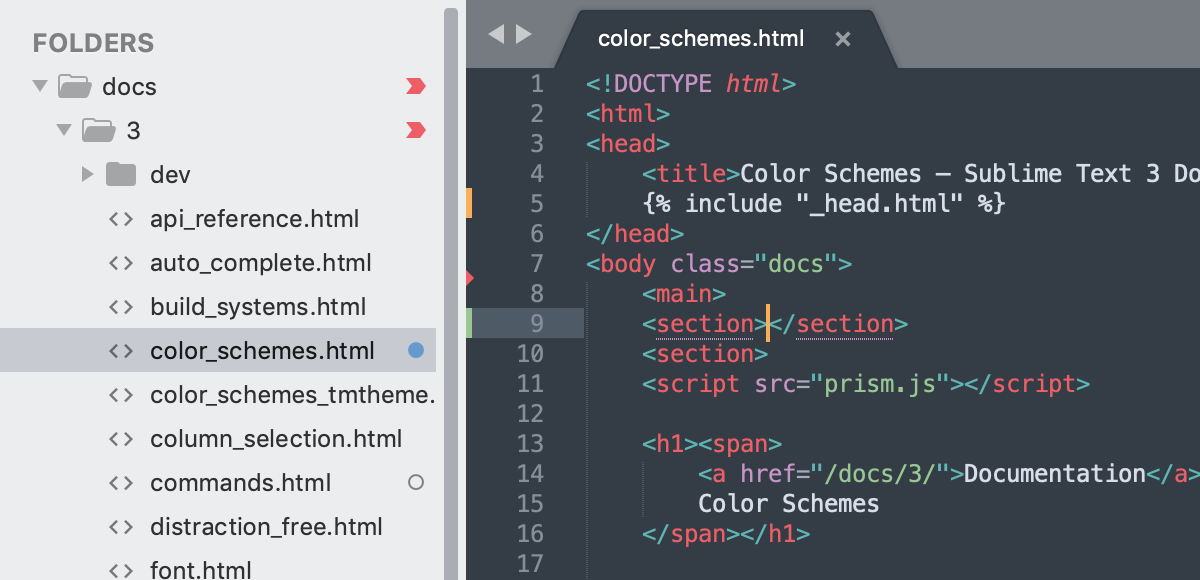

- #MAKE NEW DOCUMENT SUBLIME TEXT FOR MAC INSTALL#
- #MAKE NEW DOCUMENT SUBLIME TEXT FOR MAC UPDATE#
- #MAKE NEW DOCUMENT SUBLIME TEXT FOR MAC UPGRADE#
- #MAKE NEW DOCUMENT SUBLIME TEXT FOR MAC FULL#
- #MAKE NEW DOCUMENT SUBLIME TEXT FOR MAC CODE#
Up an example and quickly see the evaluated expression or result.
#MAKE NEW DOCUMENT SUBLIME TEXT FOR MAC CODE#
Worksheets are a great way to explore an api, try out an idea, or code It's recommended to exclude these directories and files Working with Ammonite scripts will place compiled scripts into the. project/project/metals.sbt relative to the sbt file. To support each *.sbt file Metals needs to create an additional file at Project directories depending on how deep *.sbt files need to be supported. Metals.sbt file, which is added at project/metals.sbt as well as further The Bloop plugin that generates Bloop configuration is added in the Theīloop compile server places logs and compilation artifacts in the. The Metals server places logs and other files in the.
#MAKE NEW DOCUMENT SUBLIME TEXT FOR MAC UPDATE#
Update the "server_version" setting to try out the latest pending Metalsįeatures by accessing Preferences > Package Settings > LSP > Servers > LSP-metals Versionįiles and Directories to include in your Gitignore # In the "Preferences > Preferences: LSP Settings": (without mixing them with the default ones from Sublime) set the following setting If you prefer to only enable Metals completions This paragraph contains a few tips & trick that can improve your daily productivity with Metals. Tweaking Sublime Text for a better productivity # You can optionally register a key binding for the command. You can search for symbols in your dependency source using the command palette. Sources with "Goto definition" by pressing F12. Once the sources have compiled successfully, you can navigate the the Once the import step completes, compilation starts for your open *.scalaįiles. You can optionally add key binding for this command. Sbt bloopInstall run lsp toggle server panel in the command palette. Server logs #įor more detailed information about what is happening behind the scenes during For example, this step can take anywhere from 10 seconds in small cached builds up to 10-15 minutes in large un-cached builds. The exact time depends on the complexity of the build and if the library dependencies are cached or need to be downloaded. This step can take a long time, especially the first time you run it in a new This starts the Metal language server but no functionality will work yet because the Click "Import build" to start the installation step. Open Sublime in the base directory of your Scala project and it will then prompt you to import the build as long as you're using one of the supported build tools.

Next, open "Preferences > Key Binding" and register F12 to trigger goto
#MAKE NEW DOCUMENT SUBLIME TEXT FOR MAC INSTALL#
Scalameta/metals-sublime: For automatic installation of metals and custom commands.Ĭommand Palette (Cmd + Shift + P) > Install package > LSP-metals Sublimelsp/LSP: Language Server Protocol support for Sublime Text.Ĭommand Palette (Cmd + Shift + P) > Install package > LSP
#MAKE NEW DOCUMENT SUBLIME TEXT FOR MAC UPGRADE#
It's recommended to upgrade to Scala 2.12 or Scala 2.13 Installing the plugins # Note that 2.11.x support is deprecated and it will be removed in future releases. Metals is developed on many operating systems andĮvery PR is tested on Ubuntu, Windows and MacOS. Points to a valid Java 8, 11 or 17 installation. Supported, please make sure the JAVA_HOME environment variable Java 8, 11, 17 provided by OpenJDK or Oracle. Sublimelsp/LSP and scalameta/metals-sublime plugins. Note that along with the location of the file, the extension is also important, otherwise Sublime won't know what it's supposed to contain.Metals works with Sublime Text 3 thanks to the
#MAKE NEW DOCUMENT SUBLIME TEXT FOR MAC FULL#
In order to determine the scope that you want to apply (which also counts for things like Key Bindings, Snippets, Build Systems, and so on) you can select Tools > Developer > Show Scope Name from the menu (see the menu for the key binding assigned to this) to see what the full scope is for the current cursor location.Īs evidenced from the scope you mentioned in your question, scopes can be quite complex to allow you to dial in as much specificity as you want.įor the case of simple plain text, as evidenced by the command I mentioned above, the following is the example completions set to work in plain text: In order to have completions for plain text, you need to change the scope from the HTML specific scope to one for plain text. For your own customizations, the appropriate place to place the file is in your User package, which you can find via Preferences > Browse Packages from the menu.On MacOS, that would be Sublime Text > Preferences > Browse Packages. All package resource files need to be stored in a Package for Sublime to be able to find and load it.


 0 kommentar(er)
0 kommentar(er)
